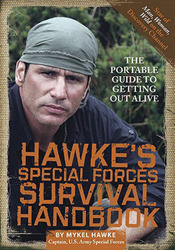Hawke’s Special Forces Survival Handbook

Best wildnerness survival guide
Let’s get this straight: you will not have your wilderness survival guidebook during a survival emergency. That’s not how emergencies work. A great survival guide book will a) assume you won’t have it with you, and b) will prepare you to survive bookless by preparing you with real details beforehand. Out of the many dozens of survival guidebooks in print today, this is the only one that accomplishes this, and this is the only one that I would recommend. (This is not a Prepper’s guide, but focuses on wildnerness survival.) It can get you thinking about real solutions to real problems. Survival is all about priorities, and I think this book lines them up in the right order. It will still be up to you to rehearse them beforehand — you won’t have this book with you.
01/3/13Excerpt
Last Resorts
You can drink urine! The rules for urine drinking are straightforward: drink it as soon after you urinate as possible; the first time you urinate is usually fine to drink; and you can drink the second pass in dire circumstances. After a second pass, chances are that you won't be urinating again anyway if there is no more fluid going in. There simply won't be any fluid left to be passed.
Myth: You will not die or get sick if you drink urine. It is not poisonous. It is actually sterile the moment it leaves your body, and only contact with the air allows for bacteria to grow. This is why you shouldn't urinate and then store it for later.
Choose a stick slightly taller than you; if the stick is too short, it may jam into your neck if you fall. It can serve as a measuring device--how deep a river is or could you jump over a chasm? If the stick is strong enough, it might even be used as a small bridge. It can be used as a rafting pole, a crutch, a spear, a reaching tool and a digging tool, etc.
*
Levels of Pain
Altert -- If you can hear a person yelling and screaming, he's okay for the moment. The noise means he's conscious, breathing, awake and talking. It's a good sign that his body is stable enough that all systems are still functioning.
*
A good rule of thumb is that green puss is bacterial, yellow is viral. This is useful for determining if you actually need that antibiotic or not when there is a cough, runny nose or phlegm.
*
Otherwise, the best source of water when surviving at sea will come from the atmosphere. If it rains, drink all you can, catch all you can, store all you can. If you have fog, then use all the cloth you can to capture that and squeeze its moisture into a container or your mouth. Try to make a solar still.
*
Try to concentrate your power-based communications in the first 24 hours, as this is when most search parties will be initiated. Broadcast your signal continuously during this window if you're able.
Consider delaying your 24-hour broadcast period for a day or two if you have reason to believe it will take folks that long to begin looking for you.
After the initial broadcast period, you'll need to go into power-conservation mode. This means spacing out the broadcasts and standardizing their length.
Transmit at dawn, dusk, noon, and midnight. Dawn and dusk are when atmospheric changes can help broadcasts travel enormous distances.
*
The Rule of Threes: There are 3 dots and 3 dashes in the 3-letter Morse code for SOS. That's no accident. The universal distress signal is anything in threes.
Hawke's Special Forces Survival Handbook: The Portable Guide to Getting Out Alive Mykel Hawke 2011, 256 pages $11










